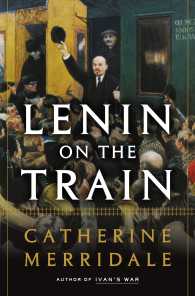- ホーム
- > 洋書
- > 英文書
- > Politics / International Relations
Full Description
Offering a single, coherent framework of the political, economic, and social phenomena that characterize post-communist regimes, this is the most comprehensive work on the subject to date. Focusing on Central Europe, the post-Soviet countries and China, the study provides a systematic mapping of possible post-communist trajectories.
At exploring the structural foundations of post-communist regime development, the work discusses the types of state, with an emphasis on informality and patronalism; the variety of actors in the political, economic, and communal spheres; the ways autocrats neutralize media, elections, etc. The analysis embraces the color revolutions of civil resistance (as in Georgia and in Ukraine) and the defensive mechanisms of democracy and autocracy; the evolution of corruption and the workings of "relational economy"; an analysis of China as "market-exploiting dictatorship"; the sociology of "clientage society"; and the instrumental use of ideology, with an emphasis on populism. Beyond a cataloguing of phenomena—actors, institutions, and dynamics of post-communist democracies, autocracies, and dictatorships—Magyar and Madlovics also conceptualize everything as building blocks to a larger, coherent structure: a new language for post-communist regimes.
While being the most definitive book on the topic, the book is nevertheless written in an accessible style suitable for both beginners who wish to understand the logic of post-communism and scholars who are interested in original contributions to comparative regime theory. The book is equipped with QR codes that link to www.postcommunistregimes.com, which contains interactive, 3D supplementary material for teaching.
Contents
List of Tables and Figures
Acknowledgments
Reader's Manual for QR Codes and Online Supplementary Material
Preface by Alena Ledeneva
Introduction
Trapped in the Language of Democratization
The Inadequacy of Existing Models for the Post-Communist Region
The Multi-Dimensional Analytical Framework: Spanning Conceptual Spaces
How It is Made: The Construction of a Conceptual Toolkit
How to Look at It: The Framework as a Structural Construction
How to Read It: A Textbook with Original Contributions
How It Unfolds: Outline of the Content
1. Stubborn Structures
1.1. Guide to the Chapter
1.2. Thesis A: Regime Type Depends on the Separation of Spheres of Social Action
1.3. Thesis B: The Separation of Spheres Followed Civilizational Boundaries
1.3.1. Civilizations and the Three Historical Regions
1.3.2. The Basic Structure of Unseparated Spheres in a Feudal Framework
1.4. Thesis C: Communist Dictatorships Arrested and Reversed the Separation of Spheres
1.4.1. The Basic Structure of Merged Spheres in Communist Dictatorships
1.4.2. The Effect of Communism on the Separation of Spheres in Different Regions
1.5. Thesis D: Democratization Did Not Change the Separation of Spheres
1.5.1. The Basic Structure of Unseparated Spheres in a Democratic Framework
1.5.2. Single-Pyramid and Multi-Pyramid Systems: The Determinants of Democratization in the Three Historical Regions
1.6. Beyond Hybridology: A Triangular Conceptual Space of Regimes
2. State
2.1. Guide to the Chapter
2.2. General Definitions: The Basic Concepts of the Framework
2.2.1. Regime, State, Violence, and Coercion
2.2.2. Elite, Ruling Elite, Patronalism, and Informality
2.3. The Dominant Principle of State Functioning
2.3.1. Societal Interest, Elite Interest, and Ideology Implementation
2.3.2. States in Democracies and Dictatorships: from Constitutional State to Party State and from Night-Watchman State through Welfare State to Developmental State
2.4. Conceptualization of States Running on Elite Interest
2.4.1. Interpretative Layers: What is the Nature of the Ruling Elite?
2.4.2. Interpretative Layers: What is the Action Targeting State Institutions?
2.4.3. Interpretative Layers: What is the Action Targeting Property?
2.4.4. Interpretative Layers: What is the Legal Status of Elite-Interested Action?
2.4.5. Combining Layers of Different Dimensions: Defining the Mafia State
2.4.6. Constitutional State vs. Mafia State: Normativity and Discretionality
2.5. Challenges to the Monopoly of Violence
2.5.1. State Failure, Violent Entrepreneurs, and Oligarchic Anarchy
2.5.2. The Legitimate Use of Violence: A Typology
2.5.3. Sub-Sovereign Mafia States
2.6. The Invisible Hand and the Grabbing Hand: A Comparative Framework for State Types
3. Actors
3.1. Guide to the Chapter
3.2. The Three Spheres of Social Action
3.3. Political Actors in the Three Polar Type Regimes
3.3.1. President/Prime Minister—Chief Patron—General Party Secretary
3.3.2. Cabinet—Patron's Court—Politburo
3.3.3. Politician—Poligarch / Political Front Man—High Level Party Cadre
3.3.4. Trustee - Patron's Hand (Smotryashchiy)—Middle/Low Level Party Cadre
3.3.5. Civil Servant—Patronal Servant—Administrative Cadre (Apparatchik)
3.3.6. State's Secret Service—Patron's Secret Service—Party's Secret Service
3.3.7. Democratic Party (Politicians' Party)—Patron's Party (Vassals' Party)— Centralized Party (Cadres' Party)
3.3.8. Governing Party—Transmission-Belt Party - State Party
3.3.9. Opposition Party—Marginalized / Domesticated / Absorbed / ....








